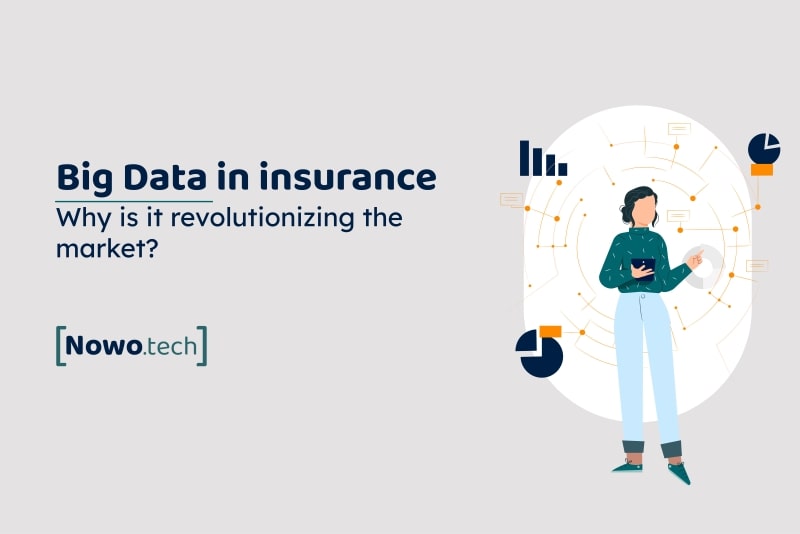Big Data is revolutionizing the market in general and, as is evident, also the insurance market. The correct use of Big Data in insurance can be very beneficial, both for the customer who has at his fingertips what he needs at all times, and for the insurer or brokerage that manages to reduce human and operating costs thanks to the automation of processes.
The latter is achieved with digital tools, such as SaaS for insurance, which significantly improve productivity and customer service.
Although at this point most insurance technologies claim to use Big Data, the reality is that they are still learning to apply it correctly. For this reason, given the ever-increasing offer in the market, we want to talk about what Big Data really is, so that you know what to expect when using a development of this type and how it can make an insurance brokerage profitable.
What is Big Data?
When we talk about “Big Data” we refer to sets, or combinations of sets of data, whose size (volume), complexity (variability) and growth rate (speed); make it difficult to capture, manage, process or analyze with conventional technologies and tools.
Some of these conventional tools can be relational databases, statistical or visualization packages…
In other words, Big Data is capable of processing massive and complex data that any conventional software could not. With this, it is possible to solve problems that until now could not be solved, to predict more refined behavior patterns…
How is Big Data applied in insurance?
Given that Big Data tries to provide an outlet for large flows of information and convert them into data correlations with their own value, in the case of insurance it is capable of providing value and treatment that the client will consider personalized. In addition, the insurer would gain a competitive advantage over the rest.
Other keys to Big Data that are very relevant in insurance are:
Artificial Intelligence
The value of AI in the insurance sector lies in its special interest in learning and detecting patterns that are repeated over and over again. In other words, it classifies existing data and designs scenarios to predict and measure future situations. Big Data is in charge of collecting all this information, so that Artificial Intelligence can detect and guess patterns.
The combination of both techniques is a benefit not only for the client, but also for the insurance company or brokerage, which knows what the client may need at any given moment, the level of claims…
Machine Learning
Thanks to Machine Learning and its machine learning capabilities, insurance data analytics solutions can be constantly processed at higher speed, accuracy and efficiency.
Machine Learning in insurance can be used retroactively on historical data that insurers already have, as well as proactively to discover new ways to improve sales processes.
Some of the applications we can see in Machine Learning are:
- Pricing strategies
- Promotional content
- Documentation processing
IoT (Internet of Things)
The IoT and its role in Big Data analytics in insurance is, in essence, virtually limitless. It gives insurers unprecedented access to information, and impacts all areas of the business. The truth is that insurance data generated by IoT can be used on our insurance website to improve:
- Risk assessment, and risk prevention.
- Marketing strategies to sell insurance
- Claims processing, in real time
- Claims leakage claims from dissatisfied customers
- Pricing
Predictive analytics
The insurance industry as a whole relies on risk and reward prediction, and one of the ways many insurers use it is through predictive analytics. Predictive analytics collects data from insurers and, among other things, uses it to calculate with greater accuracy and precision:
- Pricing and risk selection
- Claims triage
- Innovative ideas for selling insurance
- Emerging trends
What is certain is that the results of using predictive analytics in the insurance industry results in the implementation of more accurate and streamlined processes in all operations. In today’s fast-paced market, insurers cannot afford to go slow.
Unstructured data
The data most commonly used in insurance analytics is so-called structured data. This is data provided directly by consumers, such as name, address, gender, age, etc., which can be entered into standard forms and tables. This data is easily accessible and used, but does not paint the whole picture. The new frontier of insurance data analytics is unstructured data as it may include media, multimedia or reports.
Telematics
Telematics-the use of sensory technology to collect and send data in real time-is the latest trend in data collection and insurance. People have started choosing programs that analyze data from wearable devices and their cars to inform insurers about their policies, in the hope of getting lower premiums.
Advantages of implementing Big Data in the insurance industry
The emergence of Insurtech is setting the pace of digital transformation in all areas of the insurance sector.
If in the past the insurance sector was characterized by little interaction between the company providing the service and the user requesting it, today, thanks to technology, procedures have been streamlined and communication barriers have been eliminated.
The key to the whole process is the accurate analysis of user behavior patterns. Numerous analytical tools are available for this purpose. The cost of each insurance policy will depend largely on these parameters, with a commitment to total personalization.
At present, Big Data in insurance companies is applied to very specific products, such as life, health and automobile insurance. However, this analysis system will be applicable to all types of insurance in the future. The idea is to offer each customer a fast, optimal and tailored response.
For this reason, we are going to show a series of competitive advantages that you may be interested in knowing about, such as:
Price and personalized offers
Knowing your customers means that your company can adapt your products and services to their needs.
With this the user will receive a more personalized treatment based on the information that the company collects from customers, making the user experience much more effective.
One example is health insurance companies, which can improve medical care through the technological environment.
Improve communication and transparency
Improving communication and transparency thanks to Big Data will make your company’s processes faster and more efficient. Some companies already incorporate chatbots, to make the interaction with the customer flow. It may be an idea for you to incorporate it too.
As you can see, this is a big step in the evolution of the Internet , and the level of transparency is much higher, since the user has better access to coverage and economic offers.
Cross Selling and Up Selling
Cross Selling allows you to work with your client portfolio to increase the sale of the products or services you already have, although it is important to keep in mind that it is not just about selling more insurance to clients. The key is to correctly apply this technique to know who your buyer is, what their needs are and work to satisfy them, and that is where artificial intelligence, machine learning and big data act, gathering information to be able to then implement cross selling and up selling. Doing this well, sales will increase. Other benefits they bring are:
- Cost savings. Compared to the resources used to acquire new customers, this strategy is cheaper.
- Customer loyalty. If a person buys several products with the same broker, he tends to be loyal and becomes a “loyal customer”.
Would you like to know how to retain customers in your insurance company or brokerage? We tell you step by step.
Detect and avoid fraud
In addition to finding new customers, the data helps us to discover who is misusing or trying to misuse the services. It reduces fraud and helps companies avoid malicious losses.
You should note that it is possible to identify and classify customers who are more likely to not pay or who are more prone to churn. Not to mention creating risk profiles to predict fraud in the application.
Process automation
Automated updating means always offering the right coverage and greater customer convenience, giving the insurer a competitive advantage. Smart Automation on Big Data can work and maximize obtaining quality information for companies regarding their customers, business trends and relationships with third parties such as partners.
Improve Engagement
Having an expanded 360 knowledge of each of your customers can make you improve the quality of your customer relationships. This requires a single decision center that centralizes and homogenizes all customer information from different departments and analyzes engagement strategies.
Big data, thanks to its great capacity to store customer data, gives you the possibility to offer the right products at the right time in a personalized way, i.e. it would work as a crm for insurance, anticipating customer needs and always offering the price that best suits each user.
Risk forecasting
Finding certain patterns in your user’s data or behaviors can help you to apply more efficient criteria to customers and risk situations. Data availability and storage, processing power and predictive modeling techniques increase our risk quantification capabilities as Big Data minimizes risk.
Improved decision making
Data analytics improves decision making in the organization. The objective is to reduce risks by studying information coming from customers, employees or generated by sensors located on products. In this way, smart decisions can be made quickly and with the highest probability of success.
Competitive advantages
Within Big Data, you find software, technology, services, and, especially, a new approach. Learning to analyze, manage, interpret and draw conclusions from them, even in real time, is a competitive advantage for your business. That of making decisions based on predictive models.
How Nowo.tech helps you through Big Data
In Nowo.tech we know the importance of your insurance sales, so we want to show you an embedded tool for your insurance website, in which you can integrate it quickly, easily and 100% functional. Automated insurance sales in real time.
If you have any questions about this insurance software, do not hesitate to call our team of professionals to solve your doubts.









